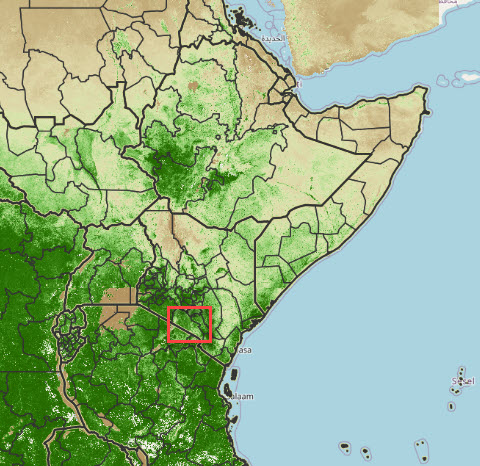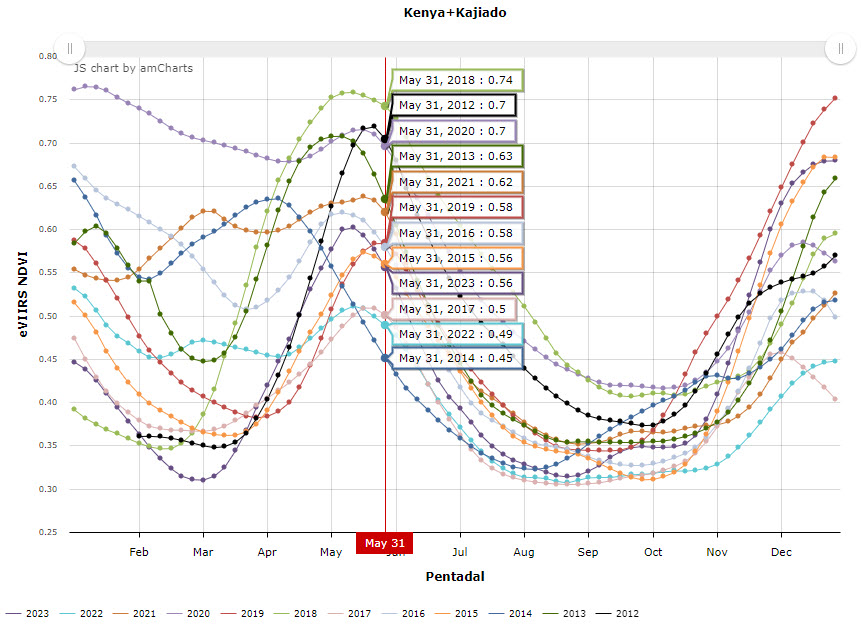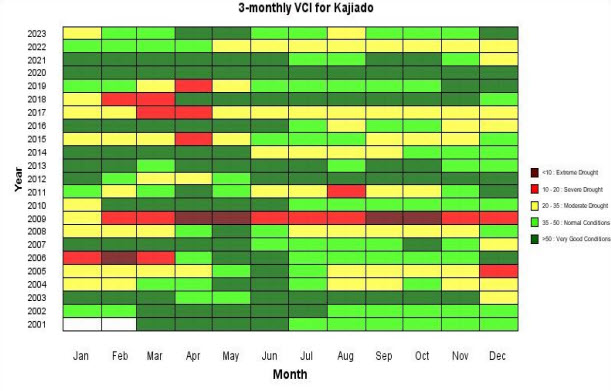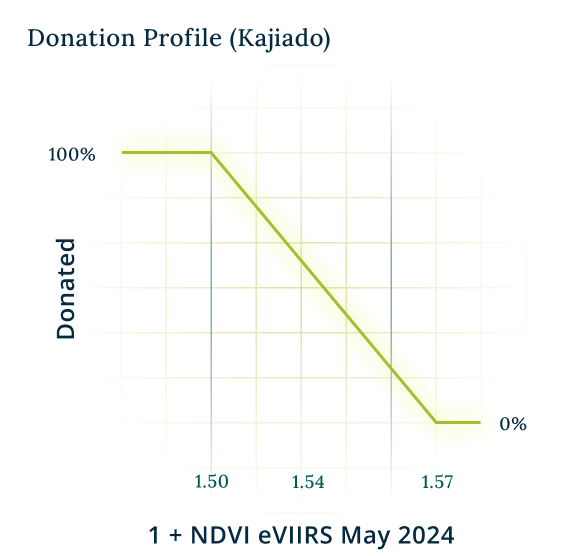
Empowering pastoralists in Kenya - The third DIVA Donate campaign
By Walodja1987 at
Following the successful conditional donation campaign for the October-November-December 2023 rainy season in collaboration with Mercy Corps Ventures, we are excited to announce the launch of the third pilot campaign under the DIVA Donate initiative. Building upon our experiences and the insights gained from the previous campaigns, this new campaign introduces a more robust NDVI metric that corrects for cloud coverage and atmospheric contamination and tests the outcome reporting via the decentralized Tellor oracle system.
Let’s dive in.
✨ About the campaign
In our third campaign, we remain dedicated to providing anticipatory cash transfers to pastoralist communities in Kenya, which are disproportionately affected by climate-change-induced drought.
The campaign’s objective is to assess vegetation health using the Normalized Difference Vegetation Index (NDVI) following the March-April-May 2024 rainy season and disburse funds to participating pastoralists if the NDVI at the end of this period suggests insufficient vegetation to support livestock during the upcoming dry season.
Given a more focused fundraising target of $10’000, compared to $25’000 in the previous campaign, the campaign concentrates on Kajiado county solely. This region was a beneficiary in the last campaign and received 16.4% of the contributed funds.
📊 Enhanced NDVI metric
The NDVI, sourced from satellite imagery, remains our key metric to evaluate the vegetation health on the ground. This time, however, we are utilizing a smoothed dataset from the USGS Famine Early Warning System Network (FEWS) that corrects for cloud coverage and atmospheric contamination.
By leveraging this enhanced dataset, we can directly use the NDVI values recorded at the end of the observation period, eliminating the need for average calculations to address the problem of contamination. The switch to this new dataset is a response to our last campaign's experience, where relying on average NDVI values led to skewed outcomes due to the influence of outliers. A comprehensive analysis and the key learnings from the previous pilot campaign are still being finalized and will be published in a separate article.

🔮 Outcome reporting
The reliability of the data reporting system is of utmost importance. In this campaign, we are adopting Tellor Oracle, a decentralized system that allows smart contracts to securely and reliably access data from off-chain sources. Tellor uses a decentralized network of staked reporters to provide this data, ensuring network integrity and discouraging false reporting. In addition, by decentralizing the data provision, we effectively eliminate the risk of a single point of failure, ensuring the system's resilience and reliability.
We will release a comprehensive guide specifically for Tellor reporters over the coming weeks, detailing the process for data retrieval and reporting.
🧑🎓 Payoff calibration
The payoff calibration process involves identifying the NDVI thresholds indicative of drought conditions to trigger disbursements to pastoralists. The first step is to look at the NDVI data. Below chart shows the FEWS NDVI data for Kajiado county, updated every 5 days and covering the last 12 years.

Source: FEWS
The chart illustrates a recurring pattern: an increase in NDVI during the March-April-May rainy season, indicating improved vegetation, followed by a decline until the end of September as the dry season progresses. Low NDVI values at the end of May imply reduced fodder for pastoralists' livestock, forecasting tougher survival conditions through the dry months.
The chart highlights the NDVI values on 31 May for the last 12 years. The values vary between 0.45 in 2014, and 0.74 in 2018, with an average NDVI value of 0.59. Without additional information, it is not possible to tell whether 0.45 represents a low or high level.
To make this assessment, we have leveraged the Vegetation Condition Index (VCI) maps published by the National Drought Management Authority (NDMA) in their monthly county reports.

Source: Kajiado DEW Bulletin-December 2023
The VCI measures the average NDVI over a 3-month period, mapping the current vegetation health to its historical range, expressed as a percentage from 0% to 100%. Lower VCI values indicate that vegetation health is near the historical minimum, whereas higher values indicate levels closer to the historical maximum. More specifically, VCI values below 20% mark severe drought conditions (highlighted by a red box), values between 20% and 35% indicate moderate drought (highlighted by a yellow box), and values above 35% reflect normal to optimal vegetation conditions (highlighted by a green box).
The presence of yellow or red boxes during the dry season months June, July, August, and September, suggests insufficient vegetation build-up during the preceding rainy season.
With this approach, we identify 2009, 2011, 2014, 2017 and 2022 as the years that experienced drought conditions. Specifically, we can see moderate drought conditions in 2014, 2017 and 2022 associated with NDVI levels of 0.45, 0.50, and 0.49, respectively, by the end of May. For the years 2009 and 2011 no specific data is available, however, the presence of red boxes suggests that NDVI levels must have been even lower. Based on these insights, we have set a full fund release for NDVI levels at or below 0.50.
To create a more equitable payout structure, we implemented a linearly increasing payout profile, starting at 0.57, slightly below the 2012-2023 average of 0.59. Historically, this selected payout structure would have distributed 100% of the contributed funds in 3 out of 12 cases and 0% in 7 out of 12 cases, underscoring the need-based approach. In the remaining two cases, the payout would have fallen within a range of 0% to 100%, following the linear payout curve.
The chosen payout profile for the campaign is depicted below (note that the NDVI value was shifted by +1 for technical reasons):

♻️ Recycling contributions
Any unreleased funds contributed by the DIVA Donate team to the previous campaign ($8’430) will be recycled and redirected to support the new campaign. In addition, the DIVA delegate has committed himself to contribute the fees withheld by DIVA Protocol at the time of payout claim during the previous campaign (~$50) to the new campaign, thereby emphasizing the flexibility inherent in DIVA Protocol‘s governance model.
Participants from the prior campaign are encouraged to claim any unreleased funds and amplify their impact by supporting the new campaign. If you haven’t claimed the funds from the previous campaign yet, learn how to do it in this video.
💡 How to participate
Participating in the campaign is simple if you have a browser wallet with USDT on Polygon. Just visit divadonate.xyz, connect your wallet, enter the amount you wish to contribute, click "Deposit" and confirm the transaction in your wallet.
Note that you may be asked to "Approve" the transfer first in order to grant DIVA Protocol the permission to move USDT on your behalf. For a step-by-step guide, you can check out the video tutorial produced for the previous campaign.

For those new to crypto, there is a one-time setup process to go through to set up a wallet and convert your local currency into crypto assets. Refer to our FAQs for more guidance. If you need support, head over to the diva-donate channel in our Discord and ask your questions.
🏆 Rewards
Consistent with previous campaigns, participants will receive a digital certificate (POAP) to commemorate their contribution. Donations of $75 or more will receive the golden-ring POAP. Smaller contributions will be rewarded with the silver POAP.
.png)
.png)
🛠️ Technical campaign details
Below are the technical details of the campaign setup, enabling everyone to monitor the fund flows and the reporting process on the Polygon blockchain:
- Donor token: 0xF253278A45fD1EB0F2B16260C9314b8740Fa94cf
- Beneficiary token: 0xC6426753264774EAB988d91DD29CfE6a626b14a0
- PoolId: 0x8c85108a28a163d1722c2140eea57f9d1cb7f83f69dfc04eb0d9e51298dea2b6
- Reference asset description stored on IPFS
- Tellor oracle adapter: 0x7950DB13cc37774614B0AA406e42a4C4f0BF26a6
🔢 DIVA Donate Statistics
Below provides the since inception statistics of the DIVA Donate initiative (excluding the new campaign):
- Number campaigns: 2
- Contributed: $25’602
- Donated: $11’744 (45.9%)
💎 Join the cause
The DIVA Donate team is actively seeking partners who share our vision of harnessing blockchain technology to launch parametric conditional donation campaigns. Given the versatile nature of DIVA Protocol, the donation payout can be linked to virtually any metric. If you represent a charity or NGO passionate about this concept, reach out and join forces to provide more efficient and effective support to vulnerable communities worldwide.
🌔 Conclusion
The third campaign emphasizes our commitment to mitigate the impact of climate change on pastoralist communities in Kenya. By enhancing the NDVI metric, we aim to provide more precise and impactful support. The incorporation of the Tellor oracle for outcome reporting reflects our dedication to improving the reliability of our solution. We are grateful for the continued support of our donors and partners and look forward to making a meaningful difference in the lives of those we serve. Together, we can continue to empower communities and foster resilience against the challenges posed by climate change.
🍀 About DIVA Donate
DIVA Donate is an innovative platform that leverages blockchain technology to enable parametric conditional donations. It is a joint initiative between two entities united around the mission of empowering vulnerable communities affected by climate change:
- Fortune Credit: a microfinance institution in Kenya which provides credit, insurance & other financial services to 50k+ customers including small-holder farmers & pastoralists, and
- DIVA Technologies AG: developer of DIVA Protocol, a smart contract-based system for creating and managing custom derivative contracts peer-to-peer.